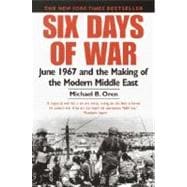
Note: Supplemental materials are not guaranteed with Rental or Used book purchases.
Purchase Benefits
What is included with this book?
| List of Maps | |
| Acknowledgments | |
| A Note on Sources and Spellings | |
| Foreword | |
| The Context: Arabs, Israelis, and the Great Powers, 1948 to 1966 | p. 1 |
| The Catalysts: Samu' to Sinai | p. 33 |
| The Crisis: Two Weeks in May | p. 61 |
| Countdown: May 31 to June 4 | p. 127 |
| The War: Day One, June 5 | p. 170 |
| Day Two, June 6 | p. 211 |
| Day Three, June 7 | p. 240 |
| Day Four, June 8 | p. 257 |
| Day Five, June 9 | p. 278 |
| Day Six, June 10 | p. 294 |
| Aftershocks: Tallies, Postmortems, and the Old/New Middle East | p. 305 |
| Afterword | p. 328 |
| A Conversation with Michael B. Oren | p. 332 |
| Notes | p. 342 |
| Bibliography and Sources | p. 416 |
| Index | p. 434 |
| Table of Contents provided by Blackwell. All Rights Reserved. |
The New copy of this book will include any supplemental materials advertised. Please check the title of the book to determine if it should include any access cards, study guides, lab manuals, CDs, etc.
The Used, Rental and eBook copies of this book are not guaranteed to include any supplemental materials. Typically, only the book itself is included. This is true even if the title states it includes any access cards, study guides, lab manuals, CDs, etc.
Excerpted from Six Days of War: June 1967 and the Making of the Modern Middle East by Michael B. Oren
All rights reserved by the original copyright owners. Excerpts are provided for display purposes only and may not be reproduced, reprinted or distributed without the written permission of the publisher.